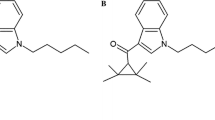Abstract
A hitherto unknown glutathione-S-transferase in human erythrocytes displays polymorphism: three quarters of the population (“conjugators”) possess, whereas one quarter (“non-conjugators”) lack this specific activity. A standard method for the identification of conjugators and non-conjugators with the use of methyl bromide and gas chromatography (head space technique) is described. Three substrates of the polymorphic enzyme, methyl bromide, ethylene oxide and dichloromethane (methylene chloride), were incubated in vitro with individual whole blood samples of conjugators and non-conjugators. All three substances led to a marked increase of sister chromatid exchanges (SCE) in the lymphocytes of the non-conjugators but not in those of conjugators. A protective effect of the glutathione-S-transferase activity in human erythrocytes for the cytogenetic toxicity of these chemicals in vitro is thus confirmed. Since the enzyme activity is not found in erythrocytes of laboratory animals, species extrapolations for risk assessment of methyl bromide, ethylene oxide and dichloromethane should be reconsidered.
Similar content being viewed by others
References
Bolt HM (1992) Zur Problematik der Risikoextrapolation am Beispiel von Dichlormethan (Methylenchlorid). In: Horst A, Norpoth K, Verkoyen C (eds) Krebsrisiken am Arbeitsplatz. Springer-Verlag, Berlin
CEC, Commission of the European Communities (1990) Dichloromethane. In: Berlin A, Draper M, Krug E, Roi R, Van der Venne M (Eds.) The toxicology of chemicals, 1: Carcinogenicity, Vol. II. Luxembourg, pp 67–74
Danse LH, van Velsen FL, van der Heijden CA (1984) Methyl bromide: carcinogenic effects in the rat forestomach. Toxicol Appl Pharmacol 72: 262–271
Doom R van, Borm PJA, Leijdekkers CM, Henderson PT, Reuvers J, van Bergen TJ (1980) Detection and identification of S-methylcysteine in urine of workers exposed to methyl chloride. Int Arch Occup Environ Health 46: 99–109
ECETOC (1989) Technical Report No. 34: Methylene chloride (dichloromethane): an overview of experimental work investigating species differences in carcinogenicity and their relevance to man. ECETOC, Brussels
Föst U, Hallier E, Ottenwälder H, Bolt HM, Peter H (1991) Distribution of ethylene oxide in human blood and its implications for biomonitoring. Hum Exp Toxicol 10: 25–31
Garry VF, Opp CW, Wiencke JK, Lakatua D (1982) Ethylene oxide induced sister chromatid exchange in human lymphocytes using a membrane dosimetry system. Pharmacology 25: 214–221
Grammer LC, Roberts M, Nicholls AJ, Plattz MM, Patterson R (1984) IgE against ethylene oxide-altered human serum albumin in patients who have had acute dialysis reactions. J Allergy Clin Immunol 74: 544–549
Hallier E, Deutschmann S, Reichel C, Bolt HM, Peter H (1990) A comparative investigation of the metabolism of methyl bromide and methyl iodide in human erythrocytes. Int Arch Occup Environ Health 62: 221–225
Hearne FT, Grase F, Pifer JW, Friedlander BR, Raleigh RL (1987) Methylene chloride mortality study: dose-response characterization and animal model comparison. J Occup Med 29: 217–228
IARC International Agency for Research on Cancer (1986) Dichloromethane. IARC Monogr 41: 43–85
IARC International Agency for Research on Cancer (1987) Overall evaluations of carcinogenicity: an updating of IARC Monographs Volumes 1–42. IARC Monogr Suppl 7
Iwasaki K, Ito I, Kagawa J (1989) Biological exposure monitoring of methyl bromide workers by determination of hemoglobin adducts. Ind Health 27: 181–183
Nolan RJ, Rick DL, Landry TD, McCarty LP, Agin GL, Saunders JH (1985) Pharmacokinetics of inhaled methyl chloride (CH3Cl) in male volunteers. Fundam Appl Toxicol 5: 361–369
NTP National Toxicology Program (1986) Toxicology and carcinogenesis studies of dichloromethane (methylene chloride) (CAS No. 75-09-2) in F344/N rats and B6C3F1 mice (inhalation studies) (Technical Report No. 306). US Department of Health and Human Services, Washington DC
NTP National Toxicology Program (1992) Technical Report on the toxicology and carcinogenesis studies of methyl bromide in B6C3F1 mice (inhalation studies) (Technical Report No. 385). US Department of Health and Human Services, Washington, DC
Pavkov KL, Kerns WD, Chrisp CE, Thake DC, Persing RL, Harroff HH (1988) Major findings in a twenty-four month inhalation toxicity study of methyl chloride in mice and rats. Toxicologist 2: 161 (Abstract No. 566)
Perry P, Wolff S (1974) New Giemsa method for the differential staining of sister chromatids. Nature 251: 156–158
Peter H, Deutschmann S, Reichel C, Hallier E (1989) Metabolism of methyl chloride in human erythrocytes. Arch Toxicol 63: 351–355
Reuzel PGJ, Dreef-van der Meulen HC, Hollanders VMH, Kuper CF, Feron VJ, van der Heijden CA (1991) Chronic inhalation toxicity and carcinogenicity study of methyl bromide in Wistar rats. Food Chem Toxicol 29: 31
Sarto F, Cominato I, Pinton AM, Brovedani PG, Faccioli CM, Bianchi V, Levis AG (1984) Cytogenetic damage in workers exposed to ethylene oxide. Mutat Res 138: 185–195
Schröder KR, Hallier E, Peter H, Bolt HM (1992) Dissociation of a new glutathione S-transferase activity in human erythrocytes. Biochem Pharmacol 43: 1671–1674
Thier R, Föst U, Deutschmann S, Schröder KR, Westphal G, Hallier E, Peter H (1991) Distribution of methylene chloride in human blood Arch Toxicol Suppl 14: 254–258
Tucker JD, Xu J, Stewart J, Ong T (1985) Development of a method to detect volatile genotoxins using sister chromatid exchanges. Environ Mutagen 7 [Suppl.3]: 48
Author information
Authors and Affiliations
Rights and permissions
About this article
Cite this article
Hallier, E., Langhof, T., Dannappel, D. et al. Polymorphism of glutathione conjugation of methyl bromide, ethylene oxide and dichloromethane in human blood: Influence on the induction of sister chromatid exchanges (SCE) in lymphocytes. Arch Toxicol 67, 173–178 (1993). https://doi.org/10.1007/BF01973304
Received:
Accepted:
Issue Date:
DOI: https://doi.org/10.1007/BF01973304



